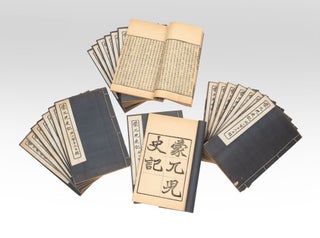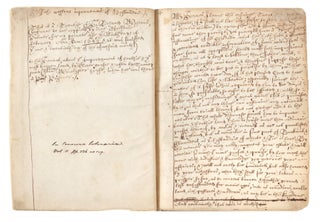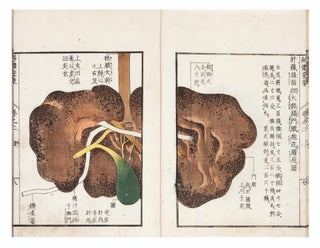The Vegetables vs. the Fish
Manuscript on fine paper of Shojin gyorui monogatari [Tale of Vegetables and Fish].
30 leaves, one blank leaf at end with scholarly annotations dated 1927, all on fine torinoko paper. Small 4to (240 x 178 mm.), decchoso (“butterfly”) binding of early decorated navy blue wrappers (a few careful repairs, one leaf sprung); landscapes of pine trees with mist, all in gold & gold “mud,” painted on covers; orig. orange manuscript title label on upper wrapper. [Japan: mid-Edo].
A beautifully written and bound manuscript of Shojin gyorui monogatari, a fascinating parody of the Heike monogatari [Tale of Heike], a historical epic written in the late 12th or early 13th century. Tale of Heike, second only in importance to Tale of Genji, was recycled and reworked in later centuries, and has been an inexhaustible source of inspiration for novelists and poets. It has also been used as a parody of current events and problems or as a basis for fictional stories about plants or animals, including the present Shojin gyorui monogatari [Tale of Vegetables and Fish], written in the Muromachi period. It describes an imaginary battle between vegetable and non-vegetable foods.
Our manuscript is finely written on high-quality torinoko paper in a combination of kanji and hiragana, with accompanying furigana. There is much on food culture: seasonal cuisines and delicacies, the merits of sober versus rich diets, special regional vegetables, agricultural rituals, etc. There are very early references to natto (fermented soybeans).
“The plot of Shojin gyorui monogatari can be summarized as follows. In the first year of the Fish-Bird era, the Roe brothers, sons of Lord Salmon Osuke Long-Fin, are attending a formal ceremony at the imperial palace. They get extremely upset when they see that Natto Taro Big-Seeds is seated close to Shogun Rice while they are demoted to the lowest seats, and they decide to return home. Their father cannot tolerate this affront to their dignity and decides to raise an army of fishes, mollusks, birds, and animals to attack Natto’s father, Lord Soy, whose defense force comprises seaweeds, vegetables, roots, beans, sweets, and fruits. After fierce fighting, the attacking troops are defeated and both Osuke and his sons are killed.”–Elena Follador, “Re-contextualizing Shojin gyorui monogatari, or When the Fish Declared War on the Greens” in Japan Review, No. 35 (2020), p. 34. Her article offers many fresh perspectives and should be studied; she explains the many complexities and meanings within this text.
Our work is part of the rich tradition within Japanese literature of gijinka; it is one of the earliest instances of irui gassen mono (tales of battles between nonhuman beings). Such anthropomorphism, attributing human characteristics to a god, animal, or object, is often used in witty parodies or satires, filled with puns. These nonhumans could freely criticize current events or employ reworked historical stories behind the shield of gijinka for satiric and literary purposes.
Fine copy, preserved in a chitsu. Minor worming and evidence of stabholes (the manuscript was once conventionally bound).
Price: $5,500.00
Item ID: 7907

![Item ID: 7907 Manuscript on fine paper of Shojin gyorui monogatari [Tale of Vegetables and Fish]. SHOJIN GYORUI MONOGATARI.](https://jonathanahill.cdn.bibliopolis.com/pictures/7907.jpg?width=768&height=1000&fit=bounds&auto=webp&v=1640379148)
![Manuscript on fine paper of Shojin gyorui monogatari [Tale of Vegetables and Fish].](https://jonathanahill.cdn.bibliopolis.com/pictures/7907_2.jpg?width=320&height=427&fit=bounds&auto=webp&v=1640379148)



